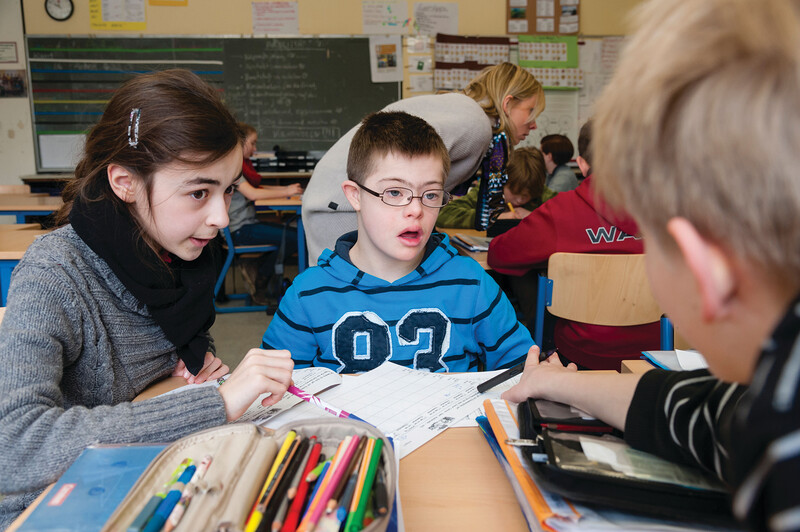This issue not only shares ideas for teaching students with learning differences (from dyslexia to autism to deafness), it also explores how educators' perception of disabilities and differences is changing—and whether it should change more. In the lead article ("Neurodiversity: The Future of Special Education?"), Thomas Armstrong argues that special education is "weighed down by a history emphasizing deficit, disorder, and dysfunction" and needs to change its approach.
- Do you agree with Armstrong? Or do you think the approach currently used for providing special education services is the most appropriate and helpful one for kids?
- What do you think of the alternative approach Armstrong recommends, neurodiversity—the idea that ability differences should be honored like other human variations rather than seen as deficits? Christina Yuknis and coauthors embody this perspective in "Supporting Deaf Students—and All Students," noting, "At Gallaudet [University], being deaf is not only the normal, everyday way of being; it is cherished." How might the special ed system change if it used this approach? How might students' lives be different?
- Neurodiversity emphasizes a learner's strengths. Look over the strengths-finding assessments Armstrong mentions on p. 13. If possible, try giving one of these assessments to some or all of your students. What did you learn and how might you use that to improve your instruction?
To Label or Not to Label?
Armstrong says it's a problem that special education "holds fast" to the diagnostic categories it puts students into. Similarly, Deborah Wolter ("From Labels to Opportunities") says that teachers' tendency to put labels on a struggling student often actually thwarts that student's progress. When a student gets a disability label, he or she is often segregated from the rich instruction peers enjoy–and gets stuck receiving remedial instruction that demotivates and keeps that student behind.
- Do you agree with Armstrong and Wolter that labeling a student as having a disability is itself a problem? How have you seen this play out in your school? Do students with a "label" usually spend much of their day separated from mainstream peers and instruction? What is their instruction like?
- When might a label be helpful and when might it create a problem? How can a teacher know when referring a particular student for testing is the right thing to do and when it might do harm?
Kyle Redford ("Dyslexia: Disability or Difference?") has a different take on "to label or not to label," especially for students with dyslexia. Redford acknowledges that dyslexia confers some advantages so that perhaps it's time to stop labeling it a "disability" and celebrate it as a "neurodifference" (a point Fernette Eide also makes in the online-only article "Recognizing Dyslexia's Strengths in the Classroom"). But Redford gives this caveat:
Before we declare that dyslexia need not be categorized as a learning disability, we have to recognize how dyslexia expresses itself in academic environments … My dyslexic students still have to work harder than their non-dyslexic counterparts, and many activities take them longer … So instead of rushing to uproot the word disability, we must first appreciate the purpose and protections that it confers upon the individuals it covers. Dyslexia advocates have fought long and hard for policies that support dyslexics in school settings …. If dyslexia were not a learning disability, dyslexics would not need these critical protections provided by the Americans with Disabilities Act to succeed in school.
- Do you think dyslexic students need the protection of an official label to flourish in school—and that we should keep calling dyslexia a "disability?" What about ADHD, Emotional Disability, or other differences? What would be the result in schools if such diagnostic labels were dropped? How could the need for special education services and an appreciation for neurodiversity be balanced or combined?
The Strategies Are the Thing
In "How Did You Get to Harvard?" Thomas Hehir maintains that it's not the presence or absence of a label that makes the difference in whether a student with a learning difference flourishes. It's whether that learner identifies strategies that help her or him compensate for the challenges—often with the help and encouragement of a teacher. Hehir interviewed 16 Harvard students with a disability about how they overcame difficulties associated with that disability to get to the Ivy League.
- Consider various things K–12 teachers involved with these learners did to support their learning and show their belief in them: recommending intellectually challenging books, publically highlighting a talent, explicitly teaching a student how to extract information from a text, offering access to assistive technology. Pick one of these actions (or a similar one) that might help a student of yours with a learning difference. Try it in the coming weeks. Report to the group what happens.
- Look at some of the messages teachers gave these students that made a difference, such as "You've got something to look out for" or "There's more than one way to skin a cat." How might you give a struggling kid such a message?
Toward Partnerships with Parents
In "IEP Meetings: Building Compassion and Conversation," Janice Fialka and Emma Fialka-Feldman take on how to make these meetings more of a true partnership–how we can help family members feel supported rather than intimidated and reap the benefit of parents' knowledge about their kids.
- Do these descriptions of awkward, less-than-productive IEP meetings ring true for you?
- Which of the suggestions the authors provide for improving IEP meetings might you try? Look over the "One-Pager" included with the article. Might this be a good tool to use to start off a meeting with a family?








